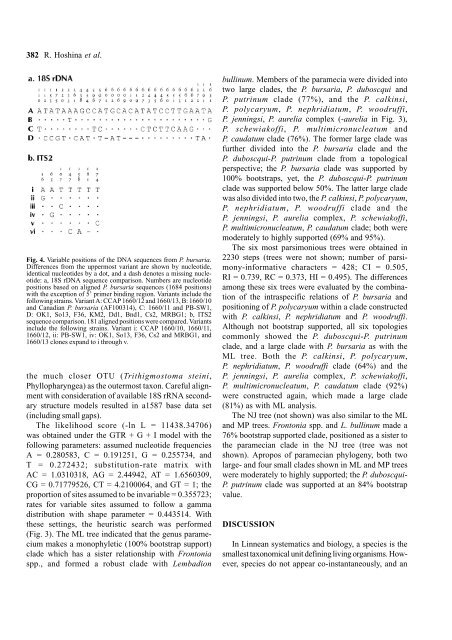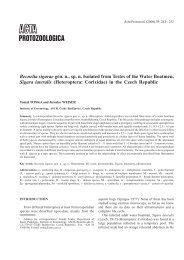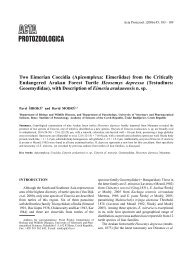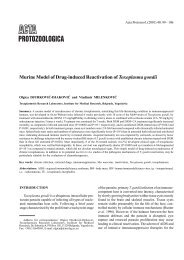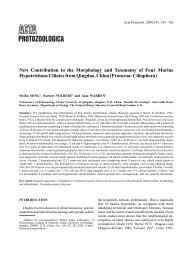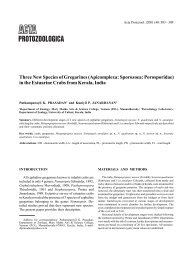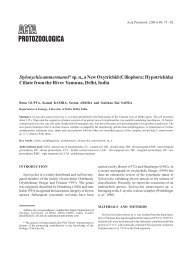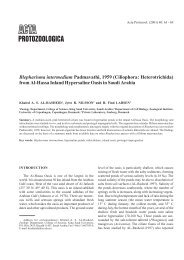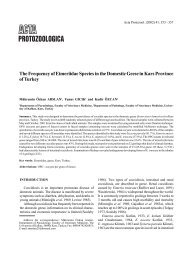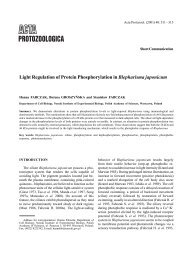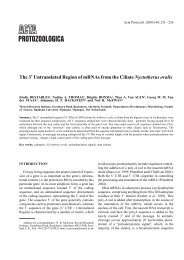Intraspecific Genetic Divergence of Paramecium ... - CiteSeerX
Intraspecific Genetic Divergence of Paramecium ... - CiteSeerX
Intraspecific Genetic Divergence of Paramecium ... - CiteSeerX
Create successful ePaper yourself
Turn your PDF publications into a flip-book with our unique Google optimized e-Paper software.
382 R. Hoshina et al.<br />
Fig. 4. Variable positions <strong>of</strong> the DNA sequences from P. bursaria.<br />
Differences from the uppermost variant are shown by nucleotide,<br />
identical nucleotides by a dot, and a dash denotes a missing nucleotide:<br />
a, 18S rDNA sequence comparison. Numbers are nucleotide<br />
positions based on aligned P. bursaria sequences (1684 positions)<br />
with the exception <strong>of</strong> 5’ primer binding region. Variants include the<br />
following strains. Variant A: CCAP 1660/12 and 1660/13, B: 1660/10<br />
and Canadian P. bursaria (AF100314), C: 1660/11 and PB-SW1,<br />
D: OK1, So13, F36, KM2, Dd1, Bnd1, Cs2, MRBG1; b, ITS2<br />
sequence comparison. 181 aligned positions were compared. Variants<br />
include the following strains. Variant i: CCAP 1660/10, 1660/11,<br />
1660/12, ii: PB-SW1, iv: OK1, So13, F36, Cs2 and MRBG1, and<br />
1660/13 clones expand to i through v.<br />
the much closer OTU (Trithigmostoma steini,<br />
Phyllopharyngea) as the outermost taxon. Careful alignment<br />
with consideration <strong>of</strong> available 18S rRNA secondary<br />
structure models resulted in a1587 base data set<br />
(including small gaps).<br />
The likelihood score (-ln L = 11438.34706)<br />
was obtained under the GTR + G + I model with the<br />
following parameters: assumed nucleotide frequencies<br />
A = 0.280583, C = 0.191251, G = 0.255734, and<br />
T = 0.272432; substitution-rate matrix with<br />
AC = 1.0310318, AG = 2.44942, AT = 1.6560309,<br />
CG = 0.71779526, CT = 4.2100064, and GT = 1; the<br />
proportion <strong>of</strong> sites assumed to be invariable = 0.355723;<br />
rates for variable sites assumed to follow a gamma<br />
distribution with shape parameter = 0.443514. With<br />
these settings, the heuristic search was performed<br />
(Fig. 3). The ML tree indicated that the genus paramecium<br />
makes a monophyletic (100% bootstrap support)<br />
clade which has a sister relationship with Frontonia<br />
spp., and formed a robust clade with Lembadion<br />
bullinum. Members <strong>of</strong> the paramecia were divided into<br />
two large clades, the P. bursaria, P. duboscqui and<br />
P. putrinum clade (77%), and the P. calkinsi,<br />
P. polycaryum, P. nephridiatum, P. woodruffi,<br />
P. jenningsi, P. aurelia complex (-aurelia in Fig. 3),<br />
P. schewiak<strong>of</strong>fi, P. multimicronucleatum and<br />
P. caudatum clade (76%). The former large clade was<br />
further divided into the P. bursaria clade and the<br />
P. duboscqui-P. putrinum clade from a topological<br />
perspective; the P. bursaria clade was supported by<br />
100% bootstraps, yet, the P. duboscqui-P. putrinum<br />
clade was supported below 50%. The latter large clade<br />
was also divided into two, the P. calkinsi, P. polycaryum,<br />
P. nephridiatum, P. woodruffi clade and the<br />
P. jenningsi, P. aurelia complex, P. schewiak<strong>of</strong>fi,<br />
P. multimicronucleatum, P. caudatum clade; both were<br />
moderately to highly supported (69% and 95%).<br />
The six most parsimonious trees were obtained in<br />
2230 steps (trees were not shown; number <strong>of</strong> parsimony-informative<br />
characters = 428; CI = 0.505,<br />
RI = 0.739, RC = 0.373, HI = 0.495). The differences<br />
among these six trees were evaluated by the combination<br />
<strong>of</strong> the intraspecific relations <strong>of</strong> P. bursaria and<br />
positioning <strong>of</strong> P. polycaryum within a clade constructed<br />
with P. calkinsi, P. nephridiatum and P. woodruffi.<br />
Although not bootstrap supported, all six topologies<br />
commonly showed the P. duboscqui-P. putrinum<br />
clade, and a large clade with P. bursaria as with the<br />
ML tree. Both the P. calkinsi, P. polycaryum,<br />
P. nephridiatum, P. woodruffi clade (64%) and the<br />
P. jenningsi, P. aurelia complex, P. schewiak<strong>of</strong>fi,<br />
P. multimicronucleatum, P. caudatum clade (92%)<br />
were constructed again, which made a large clade<br />
(81%) as with ML analysis.<br />
The NJ tree (not shown) was also similar to the ML<br />
and MP trees. Frontonia spp. and L. bullinum made a<br />
76% bootstrap supported clade, positioned as a sister to<br />
the paramecian clade in the NJ tree (tree was not<br />
shown). Apropos <strong>of</strong> paramecian phylogeny, both two<br />
large- and four small clades shown in ML and MP trees<br />
were moderately to highly supported; the P. duboscqui-<br />
P. putrinum clade was supported at an 84% bootstrap<br />
value.<br />
DISCUSSION<br />
In Linnean systematics and biology, a species is the<br />
smallest taxonomical unit defining living organisms. However,<br />
species do not appear co-instantaneously, and an


